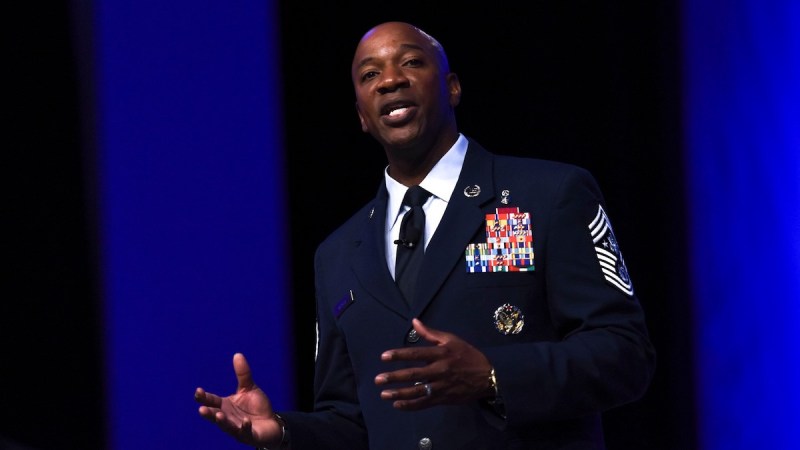It was a huge morale boost for the battle-weary soldiers living at Patrol Base Murray the morning they got a visit from the Army’s top general. They couldn’t have imagined that anyone of that importance would come to their dusty, dangerous slice of the combat zone.
It felt good, but less than an hour after he and his entourage went wheels up, five of their fellow soldiers would be dead, the victims of a cunning sniper who sucked them into his web with ruthlessly primitive tactics.
Also read: This is what goes through a sniper’s mind before the shot
The first victim was Spc. William Edwards. On a patrol outside the wire during the four-star general’s visit, he cautiously popped his Bradley’s driver hatch open three-quarters of the way to peer outside, and was shot high on his back squarely between the shoulders.

“It was a great sniper shot,” then-Lt. Col. Ken Adgie, commander of 1st Battalion, 30th Infantry, said of the clean hit, which Edwards’ platoon immediately knew had come from a three-story house about 200 meters away.
As the medics and docs in the aid station worked to save Edwards’ life, the rest of his buddies from Bravo Company, 2nd Platoon went into reaction mode and headed straight for the house to find the sniper.
The battalion, part of the 3rd Infantry Division, was on mission in the region of Arab Jabour about six miles southeast of the Baghdad, a lush agrarian area where magnificent houses that once belonged to the ruling Sunni elite grace the banks of the Tigris River.
It was now teeming with al-Qaeda operatives and their hired help. The troops called it “IED Alley” — aptly named as the division’s tally of men lost after a year in combat was more than 150, mostly to buried bombs. But the sniper threat was a constant.
The presumed sniper house was on a ribbon of land between a one-lane hardball road and the river less than a mile south of Patrol Base Murray, and 2nd Platoon had surrounded it within 15 minutes of the incident with Edwards.
Four soldiers – Sgt. Scott Kirkpatrick, Spc. Justin Penrod, Sgt. Andrew Lancaster and Staff Sgt. William Scates – went into the house to clear it. They entered through the back door.

“There was a trip wire deep in the house at the end of the hallway going into the living room. A pressure sensitive wire, something under the carpet,” Adgie said.
Unbeknownst to the soldiers, the house was booby trapped with as many as four 155 mm artillery rounds enhanced with homemade explosives and when the first soldier stepped on the trigger, it tripped a circuit and detonated the charge, blowing everyone up in a fiery explosion.
The soldiers were killed, a heavy toll that raised to five the number of soldiers the battalion lost that day, all within 30 minutes.
“The explosion was huge,” Adgie said. “Structurally the house stood, but it caught fire then burned for six hours. We had to wait for it to go out and the Navy EOD guys to go in and make sure it was safe before we could get one of the bodies out.”
Early that evening, with the scope of the tragedy barely having sunk in yet, the company commander and platoon leader went back to the house with an interpreter and climbed an inside stairway to the third floor to see if they could find a clue about the sniper.
On the wall, in Arabic, was a hateful taunt from the sniper himself, a message that read, roughly, “This is where the sniper got your guys.”
But the sniper was long gone and had left nothing behind but the note.
Infuriated by the deadly “gotcha” they had found, the unit’s human intelligence collection team went to work immediately, plying every source in every corner of their battle space to find out who the sniper was.
One of their best resources was a small team of Iraqis the battalion called their “Bird Dogs,” three men – former insurgents – who lived with the unit at Patrol Base Murray and ran a cell phone operation to reach out to a network of sympathetic friends in Arab Jabour.
The sniper, it turns out, was already famous in the Al Qaeda-friendly area for his highly successful and prominent ambush and a short 48 hours later, the U.S. soldiers, with the help of the Bird Dogs, had a name and a description.
He was Mohamed Uthman, a 5-foot, 2-inch tall foot soldier for Al Qaeda who had a reputation for being a murderous criminal. And, no surprise, he was already known as a “high value target” on a list the Americans had of their most wanted.

“Word on the street was, this is the guy who did it, and he kept on working after that. He was a cold blooded killer and he killed more Iraqis than he did Americans,” Adgie said.
The mean little sniper eluded capture for months, until one night when he made the decision to go out and kill people with the wrong insurgent mortar team.
It was December 11, 2007, four months to the day he had snuffed out the lives of the five soldiers, and Adgie cleared an Air Force F-16 hot to drop a bomb on the mortar team, unaware that Uthman was one of the teammates.
They found out after a site exploitation team identified one of the dead as the diminutive sniper.

“When Adgie lost those soldiers in that house borne IED, I flew in and we were on our knees praying and crying like babies,” said then-Maj. Gen. Rick Lynch, commander of 3rd ID. “We learned, but we learned the hard way. If something looked like it might be rigged with explosives, we just blew it up. I wasn’t going to allow my kids to go in there again because we’d already lost four.”
The tiny killer was gone, but insurgent snipers continued to bedevil the troops, said Lynch, who recalled the death of a soldier in an Abrams M1A1 tank, who, like Edwards in the Bradley, opened his hatch while the tank was on the move and was shot by a sniper from a range they estimated at about 1,000 meters.
“He’s a thinking, adaptive enemy,” Lynch said. “They watched our movements and based on their training they could pace their engagement on the rate of movement of the vehicle.”
Lynch pointed out that the division’s brigade and battalion commanders under his command had all been to Iraq at least once before and had come to know the value of having well trained and equipped sniper teams.

In Arab Jabour the sniper teams were used consistently to overwatch IED hot spots and other things like long range cameras placed on elevated platforms. The cameras provided overwatch as well, but the snipers came into play and could shoot from concealed locations if anyone messed with those cameras.
“There’s clearly a continuing role for our snipers. They found their niche on the battlefield,” Lynch said.
Gina Cavallaro is the author of Sniper: American Single-Shot Warriors in Iraq and Afghanistan.










